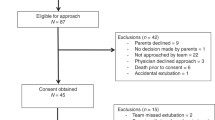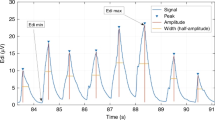Abstract
Objective:
Though nasal continuous positive airway pressure (NCPAP) is commonly used for non-invasive neonatal respiratory support, the optimal method of weaning NCPAP is not established. In this prospective, two-center randomized control trial we hypothesize that gradually increasing spontaneous breathing time off NCPAP increases successful weaning from NCPAP in infants born <31 weeks gestational age.
Study Design:
Infants were randomized to one of the two NCPAP weaning protocols, a sprinting, that is, gradually increasing spontaneous breathing time off CPAP, protocol vs a non-sprinting (weaning pressure down) protocol.
Result:
Eighty-six infants were enrolled in one of the two study groups. Thirty-one infants (77%) in the sprinting group and 30 (75%) in the non-sprinting group were successfully weaned off NCPAP at the first attempt (P>0.05). It took 1.3 (1 to 1.75) (median (IQR)) attempts and 7 (7 to 7) days to wean NCPAP off in the sprinting group vs 1.3 (1 to 1.75) attempts and 7 (7 to 10) days in the non-sprinting group (P>0.05). Additionally, no differences in the secondary outcomes of bronchopulmonary dysplasia, severe retinopathy of prematurity (⩾stage 3), periventricular leukomalacia and length of stay were noted between the two groups.
Conclusion:
Weaning NCPAP via sprinting or non-sprinting protocol is comparable, not only for successful weaning but also for the occurrence of common neonatal morbidities that impact the long-term outcome in premature infants (ClinicalTrials.gov number, NCT02819050).
This is a preview of subscription content, access via your institution
Access options
Subscribe to this journal
Receive 12 print issues and online access
$259.00 per year
only $21.58 per issue
Buy this article
- Purchase on Springer Link
- Instant access to full article PDF
Prices may be subject to local taxes which are calculated during checkout

Similar content being viewed by others
References
Finer NN, Carlo WA, Walsh MC, Rich W, Gantz MG, Laptook AR et al. Early CPAP versus surfactant in extremely preterm infants. N Engl J Med 2010; 362: 1970–1979.
Finer NN, Carlo WA, Duara S, Fanaroff AA, Donovan EF, Wright LL et al. Delivery room continuous positive airway pressure/positive end-expiratory pressure in extremely low birth weight infants: a feasibility trial. Pediatrics 2004; 114: 651–657.
Vaucher YE, Peralta-Carcelen M, Finer NN, Carlo WA, Gantz MG, Walsh MC et al. Neurodevelopmental outcomes in the early CPAP and pulse oximetry trial. N Engl J Med 2012; 367: 2495–2504.
Avery ME, Tooley WH, Keller JB, Hurd SS, Bryan MH, Cotton RB et al. Is chronic lung disease in low birth weight infants preventable? A survey of eight centers. Pediatrics 1987; 79: 26–30.
Van Marter LJ, Allred EN, Pagano M, Sanocka U, Parad R, Moore M et al. Do clinical markers of barotrauma and oxygen toxicity explain interhospital variation in rates of chronic lung disease? Pediatrics 2000; 105: 1194–1201.
Jonsson B, Katz-Salamon M, Faxelius G, Broberger U, Lagercrantz H . Neonatal care of very-low-birth-weight infants in special-care units and neonatal intensive-care units in Stockholm: early nasal continuous positive airway pressure versus mechanical ventilation: gains and losses. Acta Paediatr Suppl 1997; 419: 4–10.
Poets CF, Sens B . Changes in intubation rates and outcome of very low birth weight infants: a population-based study. Pediatrics 1996; 98: 24–27.
Gittermann MK, Fusch C, Gittermann AR, Regazzoni BM, Moessinger AC . Early nasal continuous positive airway pressure treatment reduces the need for intubation in very low birth weight infants. Eur J Pediatr 1997; 156: 384–388.
Morley CJ, Davis PG, Doyle LW, Brion LP, Hascoet JM, Carlin JB et al. Nasal CPAP or intubation at birth for very preterm infants. N Engl J Med 2008; 358: 700–708.
Kirpalani H, Millar D, Lemyre B, Yoder BA, Chiu A, Roberts RS et al. Comparing noninvasive ventilation strategies in preterm infants. N Engl J Med 2013; 7369: 611–620.
Narendran V, Donovan EF, Hoath SB, Akinbi HT, Steichen JJ, Jobe AH . Early bubble CPAP and outcomes in ELBW preterm infants. J Perinatol 2003; 23: 195–199.
Subramaniam P, Ho JJ, Davis PJ . Prophylactic nasal continuous positive airway pressure forpreventing morbidity and mortality in very preterm infants (Review). Cochrane Database Syst Rev 2016; 14 (6): CD001243.
Martin S, Duke T, Davis P . Efficacy and safety of bubble CPAP in neonatal care in low and middle income countries: a systematic review. Arch Dis Child Fetal Neonatal Ed 2014; 99: F495–F504.
Davis PG, Henderson-Smart DJ . Nasal continuous positive airway pressure immediately after extubation for preventing morbidity in preterm infants (Review). Cochrane Database Syst Rev 2003; (2): CD000143. Review.
Bamat N, Jensen EA, Kirpalani H . Duration of continuous positive airway pressure in premature infants. Semin Fetal Neonatal Med 2016; 21: 189–195.
Jardine LA, Inglis GD, Davies MW . Strategies for the withdrawal of nasal continuous positive airway pressure (NCPAP) in preterm infants. Cochrane Database Syst Rev 2011; (2): CD006979.
Amatya S, Rastogi D, Bhutada A, Rastogi S . Weaning of nasal CPAP in preterm infants: who, when and how? A systematic review of the literature. World J Pediatr 2015; 11: 212–218.
CPQCC Network Database Manual of Definitions For Infants Born in 2016. Calif Perinat Qual CARE Collab 2016;15.0:1–93.
Nair V, Swarnam K, Rabi Y, Amin H, Howlett A, Akierman A et al. Effect of Nasal Continuous Positive Airway Pressure (NCPAP) cycling and continuous NCPAP on successful weaning: a randomized controlled trial. Indian J Pediatr 2015; 82: 787–793.
Singh SD, Bowe L, Clarke P, Glover K, Pasquill A, Robinson MJ et al. Is decreasing pressure or increasing time off the better strategy in weaning VLBW infants from nasal CPAP. Eur J Pediatr 2006; 165: 48.
Soe A . Weaning from nasal CPAP in premature infants. Inspire 2007; 5: 8–10.
Todd DA, Wright A, Broom M, Chauhan M, Meskell S, Cameron C et al. Methods of weaning preterm babies <30 weeks gestation off CPAP: a multicentre randomised controlled trial. Arch Dis Child Fetal Neonatal Ed 2012; 97: F236–F240.
Rastogi S, Wong W, Gupta A, Bhutada A, Rastogi D Maimonides Neonatal Group.. Gradual versus sudden weaning from nasal CPAP in preterm infants: a pilot randomized controlled trial. Respir Care 2013; 58: 511–516.
Heath JRC, Broom M, Shadbolt B, Todd DA . CeasIng Cpap At standarD criteriA (CICADA): implementation improves neonatal outcomes. J Paediatr Child Health 2016; 52: 321–326.
Broom M, Ying L, Wright A, Stewart A, Abdel-Latif ME, Shadbolt B et al. CeasIng Cpap At standarD criteriA (CICADA): impact on weight gain, time to full feeds and caffeine use. Arch Dis Child Fetal Neonatal Ed 2014; 99: F423–F425.
Acknowledgements
Special thanks to Andrew Jacinto for his help in implementing the study, to Youngju Pak for her guidance in statistical analysis and to Michel Mikhael MD for his thoughtful review of the manuscript.
Author information
Authors and Affiliations
Corresponding author
Ethics declarations
Competing interests
The authors declare no conflict of interest.
Rights and permissions
About this article
Cite this article
Eze, N., Murphy, D., Dhar, V. et al. Comparison of sprinting vs non-sprinting to wean nasal continuous positive airway pressure off in very preterm infants. J Perinatol 38, 164–168 (2018). https://doi.org/10.1038/jp.2017.161
Received:
Revised:
Accepted:
Published:
Issue Date:
DOI: https://doi.org/10.1038/jp.2017.161
This article is cited by
-
Neonatal respiratory care practice among level III and IV NICUs in New England
Journal of Perinatology (2024)



